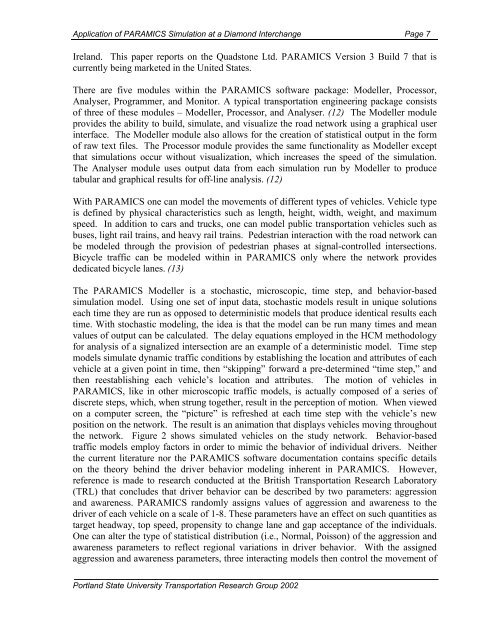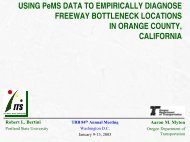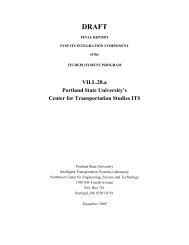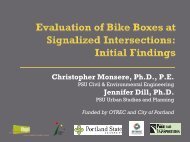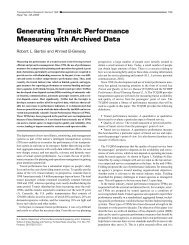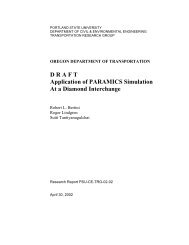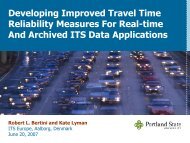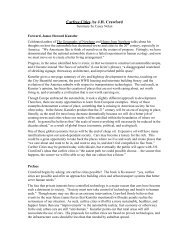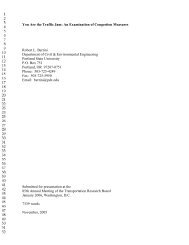D R A F T Application of PARAMICS Simulation At a Diamond ...
D R A F T Application of PARAMICS Simulation At a Diamond ...
D R A F T Application of PARAMICS Simulation At a Diamond ...
You also want an ePaper? Increase the reach of your titles
YUMPU automatically turns print PDFs into web optimized ePapers that Google loves.
<strong>Application</strong> <strong>of</strong> <strong>PARAMICS</strong> <strong>Simulation</strong> at a <strong>Diamond</strong> Interchange Page 7<br />
Ireland. This paper reports on the Quadstone Ltd. <strong>PARAMICS</strong> Version 3 Build 7 that is<br />
currently being marketed in the United States.<br />
There are five modules within the <strong>PARAMICS</strong> s<strong>of</strong>tware package: Modeller, Processor,<br />
Analyser, Programmer, and Monitor. A typical transportation engineering package consists<br />
<strong>of</strong> three <strong>of</strong> these modules – Modeller, Processor, and Analyser. (12) The Modeller module<br />
provides the ability to build, simulate, and visualize the road network using a graphical user<br />
interface. The Modeller module also allows for the creation <strong>of</strong> statistical output in the form<br />
<strong>of</strong> raw text files. The Processor module provides the same functionality as Modeller except<br />
that simulations occur without visualization, which increases the speed <strong>of</strong> the simulation.<br />
The Analyser module uses output data from each simulation run by Modeller to produce<br />
tabular and graphical results for <strong>of</strong>f-line analysis. (12)<br />
With <strong>PARAMICS</strong> one can model the movements <strong>of</strong> different types <strong>of</strong> vehicles. Vehicle type<br />
is defined by physical characteristics such as length, height, width, weight, and maximum<br />
speed. In addition to cars and trucks, one can model public transportation vehicles such as<br />
buses, light rail trains, and heavy rail trains. Pedestrian interaction with the road network can<br />
be modeled through the provision <strong>of</strong> pedestrian phases at signal-controlled intersections.<br />
Bicycle traffic can be modeled within in <strong>PARAMICS</strong> only where the network provides<br />
dedicated bicycle lanes. (13)<br />
The <strong>PARAMICS</strong> Modeller is a stochastic, microscopic, time step, and behavior-based<br />
simulation model. Using one set <strong>of</strong> input data, stochastic models result in unique solutions<br />
each time they are run as opposed to deterministic models that produce identical results each<br />
time. With stochastic modeling, the idea is that the model can be run many times and mean<br />
values <strong>of</strong> output can be calculated. The delay equations employed in the HCM methodology<br />
for analysis <strong>of</strong> a signalized intersection are an example <strong>of</strong> a deterministic model. Time step<br />
models simulate dynamic traffic conditions by establishing the location and attributes <strong>of</strong> each<br />
vehicle at a given point in time, then “skipping” forward a pre-determined “time step,” and<br />
then reestablishing each vehicle’s location and attributes. The motion <strong>of</strong> vehicles in<br />
<strong>PARAMICS</strong>, like in other microscopic traffic models, is actually composed <strong>of</strong> a series <strong>of</strong><br />
discrete steps, which, when strung together, result in the perception <strong>of</strong> motion. When viewed<br />
on a computer screen, the “picture” is refreshed at each time step with the vehicle’s new<br />
position on the network. The result is an animation that displays vehicles moving throughout<br />
the network. Figure 2 shows simulated vehicles on the study network. Behavior-based<br />
traffic models employ factors in order to mimic the behavior <strong>of</strong> individual drivers. Neither<br />
the current literature nor the <strong>PARAMICS</strong> s<strong>of</strong>tware documentation contains specific details<br />
on the theory behind the driver behavior modeling inherent in <strong>PARAMICS</strong>. However,<br />
reference is made to research conducted at the British Transportation Research Laboratory<br />
(TRL) that concludes that driver behavior can be described by two parameters: aggression<br />
and awareness. <strong>PARAMICS</strong> randomly assigns values <strong>of</strong> aggression and awareness to the<br />
driver <strong>of</strong> each vehicle on a scale <strong>of</strong> 1-8. These parameters have an effect on such quantities as<br />
target headway, top speed, propensity to change lane and gap acceptance <strong>of</strong> the individuals.<br />
One can alter the type <strong>of</strong> statistical distribution (i.e., Normal, Poisson) <strong>of</strong> the aggression and<br />
awareness parameters to reflect regional variations in driver behavior. With the assigned<br />
aggression and awareness parameters, three interacting models then control the movement <strong>of</strong><br />
Portland State University Transportation Research Group 2002


